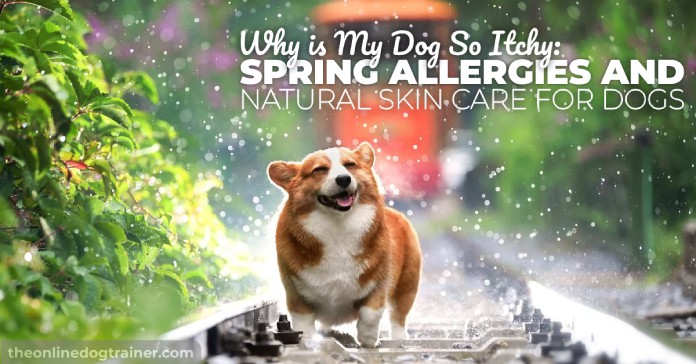
In different parts of the world, spring has sprung! And you know what that means—spring allergies.
While this time of year is often beautiful with budding trees and beautiful flowers, it can be difficult on our canine companions—especially those who like to roll around in the fresh grass!
If your pup has allergies, you may suddenly notice him/her itching, biting at their skin/paws, rubbing up against your furniture, obsessively licking themselves, or chewing off patches of hair.
With all the discomfort, your dog can do some serious damage to their skin and coat. Thankfully there are ways you can help prevent allergies from becoming a problem and/or treat your pup if they are already showing signs of being irritated.
Keep reading to find out the most common types of spring dog allergies and how you can help care for your dogs skin if he/she is itchy and uncomfortable…
The Most Common Spring Allergies for Dogs

Tree, Grass, Flower and Weed Pollen
Pollen allergies in both humans and dogs occur due to an overactive immune system.
When your pup comes in contact with pollen, it sends out a signal to your dog’s body that it is “under attack.” This signal triggers inflammation which can cause rashes, bumps, and itching.
Most dogs stand low to the grown. Their feet, belly’s, and wandering noses often plow through blooming flowers, tall grasses, or rub up against pollinating trees. This makes it very easy for a dog who has a sensitivity to end up with a reaction.
Just like humans, not all dogs are affected by pollen. However, due to genetics, tractive.com mentions that the breeds below might be more susceptible to pollen allergies…
- Pugs
- German Shepherds
- English and French Bulldogs
- Shar Peis
- Labs and Golden Retrievers
- Setters
- Terriers
Mold
In the spring, everything starts to bloom—including mold spores.
While a lot of mold is found indoors, it can also grow on damp outdoor surfaces including rocks, decks, swing sets, trees, wood piles, and more!
One of the first symptoms of mold inhalation is itchy skin. Because dogs LOVE to sniff stuff, it makes it very easy for them to inhale mold, so be careful what you’re letting your dog put his/her nose into!
Mildew
Mildew is a variant of mold—a specific type of fungus.
It needs constant moisture to grow and can be found on wooden surfaces, plants, decaying leaves, and other organic materials found outside.
Mildew is inhaled the same way mold is and has a similar reaction. For this reason, it’s important to pay attention to what your dogs are sniffing and rolling around in while outside.
How to Help Prevent & Relieve Your Dog’s Uncomfortable Allergy Symptoms

Now that you know a little bit more about the most common spring allergies, let’s take a look at what you can do to help keep your pup safe!
Here are some suggestions…
Consult a Holistic Veterinarian
As the owner of many dogs over many years I have experienced so many different rashes, gashes, cuts, bites, stings, hives and sores on my dogs! It's just part of owning dogs that love to crash and bash about in the bush and woods. (None of my dogs are couch potatoes!)
And so over the years I have made multiple trips to a number of holistic vets who have provided amazing treatments using alternative medicine. Generally speaking, this is medicine that is very gentle on the dog's body, using the most minute concentrations of medications or different blends of natural products.
The bottom line is this, nearly every time I’ve consulted a holistic vet, his/her remedy has worked to help my dog. Whether it be huge welts from bee stings, or terrible rashes from certain types of plants, my vet has been able to provide the correct treatment.
Of course not all alternative vets work the same way and so a large part of it is for you to ask around and find a good alternative vet.
And before you ask, YES I also use a more traditional vet for help with other issues!
Limit Your Dogs Outdoor Time
It’s not ideal to have to limit your dogs outside time. But, it might be necessary if your dog is truly miserable.
If your dog is not feeling well due to allergies, bring them outside for potty breaks and maybe a quick walk each day on a paved surface until the pollen and mold spores settle down. Or alternatively, monitor the areas where your dog gets the reactions. For example, I know the grass which affects my dogs and where that grass is. So at certain times of the year we stay well away!
Make up for the outdoor time by spending extra time playing fetch, tug-o-war, hide and seek or other fun games inside with your pup. This will help keep their energy levels down and keep them stimulated so your dog doesn’t go crazy indoors.
Wipe Your Dog’s Paws
Everytime your pup comes inside, be sure to wipe their feet off. Doing so will remove any pollen or mold spores that might irritate their paws.
A simple foot bath of warm water will work just fine. Pet stores also make special allergy wipes if you don’t want to deal with the mess of scrubbing your dogs feet down.
Treat Your Dog to a Coconut Oil Bath
If your dog’s skin is already irritated, a warm coconut oil bath might provide your pup with some relief.
You can find coconut oil in just about any grocery store and a large tub of it is not very expensive and goes a long way! Best of all, it’s antifungal and antimicrobial properties can help soothe, heal, and keep your pet's skin soft and healthy.
To make a coconut oil bath, simply fill your tub with warm water and add a few tablespoons of coconut oil. Wash your dog down with the coconut oil water, and then towel your pup off. You don’t have to wash off the coconut oil…it’s good for your dog’s skin!
Prevent Your Dog from Itching and Scratching
Dog’s don’t understand the dangers of scratching, biting, and chewing at itchy, irritated skin. For this reason, it’s sometimes necessary to use devices, like a soft cone, to prevent your pup from hurting himself.
While it’s not your dog’s favorite choice, preventing him from scratching and chewing can help prevent more serious issues down the road, like infections or deep skin lesions.
If you’re not sure what to buy, this kind, gentle inflatable collar is a good choice and won’t break the bank!
I recommend this inflatable collar here!
Take Your Dog for an Allergy Shot
If all else fails…
Your local vet can provide an allergy shot that will help limit the symptoms of your dogs allergies.
If your pup is strugging, your vet can evaluate the best treatment options to ensure your dog stays safe. They might also be able to prescribe a daily allergy medication, just like humans take.
Regardless of what the internet says, don’t give your dog human medications like benadryl and self-medicate at home, unless your vet has given you the “OK” to do so!
Allergies are no fun for your dog, but they can be managed! If your pet is suffering, be sure to talk to your vet, then give some of our suggestions a try!
Cheers,

~Doggy Dan 🙂





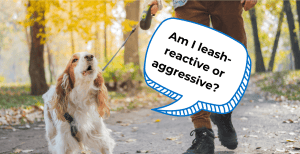
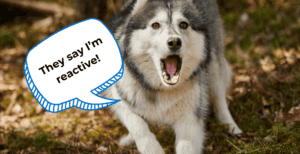
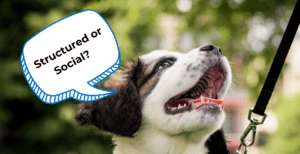
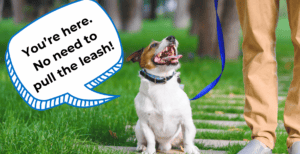

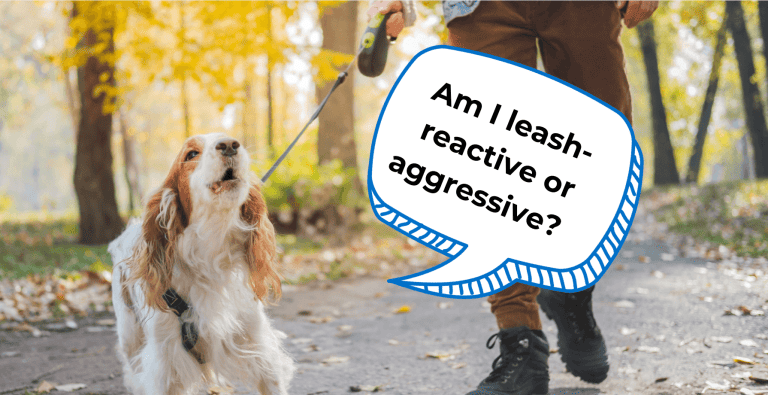
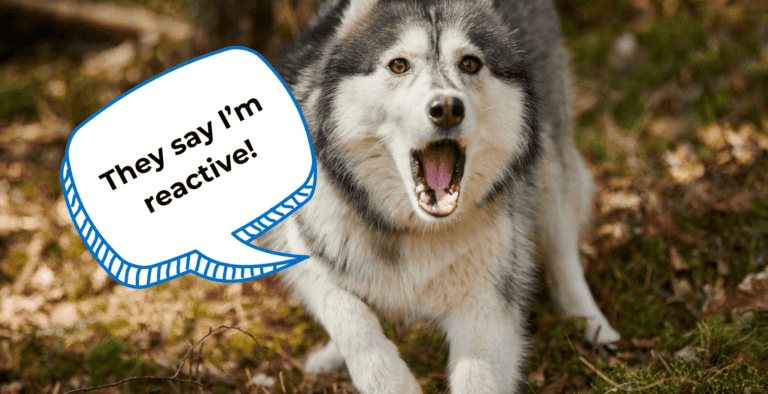

7 Responses
Why does dogs eat poop? or lick everthing
Hi Connie! Check out my Blog, linked below, where we talk about some of the odd behaviours that dogs do…including eating poop! Best, Doggy Dan
https://theonlinedogtrainer.com/why-does-my-dog-do-this-10-odd-dog-behaviors-defined/
We have a 5 yeas old English Pointer ex brood bitch.
Her skin as perfect when we adopted her 8 weeks ago,
Her chest is quite pink and she has some spots on her inner thighs.
Our vet prescribed a gel, with antibiotic qualities.
We want her to have an active real dog’s life.
How can we help her, other than restricting her to mown grass. She loves the outdoors.
Hi Irene….if your dog suffers from allergies to grasses and pollen then something you can try is wiping their belly and legs down with a wet cloth or light rinse of water, if she has been exposed to grassy areas. Calendula flower tea can be used to take the itch away. However seeking Veterinary advice is always important. Best, Doggy Dan
I have never thought about skincare for dog before. Thanks for broadening my knowledge!
Dog’s News & Stories
I have a border collie that is constantly chewing and biting at her paws, tummy, tail. HELP
Hi Barbie, if the chewing and biting is chronic then the first thing I would do is have a chat with your Vet. They will be able to diagnose the cause, as well as provide your dog with relief from the discomfort she is feeling. We also need to consider whether this is a behavioural issue…it’s also common for dogs to bite and chew themselves as a result of stress and anxiety. It’s best to first rule out any medical causes first! Best, Doggy Dan